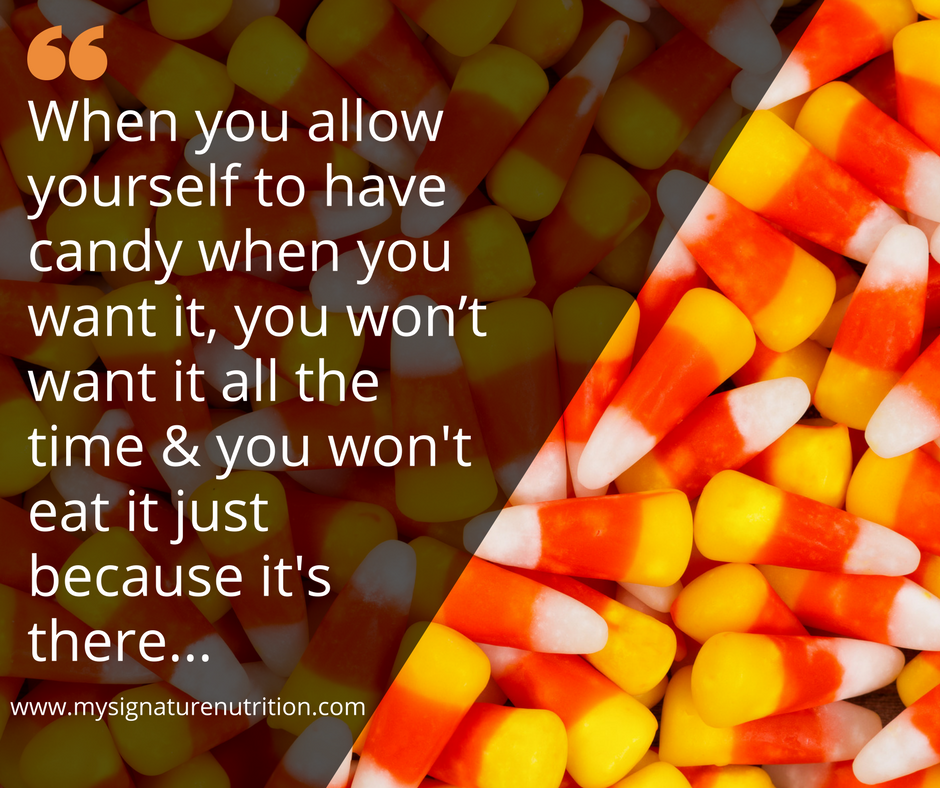Making Peace With Candy (For You & Your Children)
October 26th, 2017 by Sara Upson
This may seem like a confession, but it isn’t- I’m a dietitian and I love candy. Well I loved candy, now I would say I just like it. And the only reason this relationship has really changed from love to like is because I can have candy whenever I want it. Turns out when you allow yourself to have something when you want it, you don’t want it all the time.
Growing up, candy wasn’t necessarily restricted, but it wasn’t something we had often. Halloween was the time we got to have as much as we wanted (that night only). Then we were allowed to have 2 pieces or so daily until it ran out, or until it got to all the nasty candy that we didn’t like and wouldn’t eat. (Remember those black and orange nougat things? I still don’t even know what they are.) The only other times that candy was allowed was pretty much holidays or birthdays. Otherwise candy was off limits. The problem was, I loved candy! I wanted it all the time. To the point that I when I was 3 or 4 I was pretending that one of my toys was candy and I accidently swallowed it. Oops. Luckily it turned out fine. Or the time I cut myself while trying to open a bag of skittles with a knife when my parents said no. Or when I would hide candy in my room…
I’ve heard other parents talk about finding candy in their children’s room and how they believe they need to work harder to manage their children’s candy and keep it out of the house. Unfortunately, when you manage candy in this way it only increases the focus on candy, creates restriction, build distrust and reinforces the need for your child to hide candy and binge on candy. It makes sense- if your child doesn’t get candy and they like it, then whenever it is available they will over eat it just because it is there- even if they’re not hungry.
Around this time of the year I hear so much talk about what will you do with your child’s
Halloween candy? Do the switch witch? buy it from them? donate it? The problem with this is that it restricts candy, establishes it as a forbidden food and promotes body distrust. This leads to increased food thoughts about candy, increased focus on candy, over eating candy when it is available, eating candy even though not hungry just because it is there. A study was recently published that found when children are allowed candy they eat less of it. It literally said, if you want your children to eat less sugar, stop restricting it! A scary thought, I know!
The irony is, parents who diligently control their child’s candy intake only increase consumption of candy in the long run. For many people this isn’t even about their child or their child’s ability to control candy- it’s about their own relationship with candy and their mistrust…
For most people the idea of allowing candy or eating it whenever you want is scary. Scary for you, scary for your child. When you can’t trust yourself with candy it can be unbelievable that you could ever trust your child with candy. Since you don’t trust yourself, you won’t trust your child and will believe that it has to be regulated, restricted, forbidden even. When you do this, you don’t teach your child how to have a healthy relationship with candy. When you do this, you teach them to be afraid of candy and fun foods. You tell them that they can’t trust their body and then the cycle of being out of control with candy continues. As a parent when you utilize the switch witch or donate candy etc you completely miss an opportunity to help you and your child learn moderation and how to develop a healthy relationship with food- particularly candy.
So here is what I recommend instead. These recommendations are based on Ellyn Satter’s Division of Responsibility with feeding. You can find more information on her website here or in any of her books. The Feeding doctor, Katja Rowell, also has lots of information on her website.
I fully recognize that this recommendation may sound crazy or scary at the least, but it is backed by research and will help improve your child’s relationship with food. It may even amaze you.
- Allow your child to have as much candy as they want on Halloween. Dump it out, sort through it, look over it, talk about your favorites and why you like them, have fun!
- Then offer candy with meals and snacks going forward. Satter recommends 2-3 pieces at meals and as much as they want at snacks. Include a glass of milk for balance.
This method is based off of Ellyn Satter’s Division of Responsibility with Feeding which says- as a parent you decide, what, when and where your child will eat. Your child decides how much and if they will eat. You can learn more about this approach here. I encourage you to give it a try because what you will find is that your kids will sometimes want candy and then they’ll be done. They won’t over eat it or be “out of control, ” they’ll stop hiding it in their room and candy will just be candy.
Learn more about rejecting diet culture and making peace with food by getting your free guide.









November 01, 2017 at 2:09 am, Bruce Martin said:
Sarah i enjoyed your blog on making peace with candy. Very insightful! I would not have believed the ” eat all the candy you want” recommendation and Ellen Satter’s Division of Responsibility research; but your blog explained it very well. Tonight is halloween- our church had a trunk or treat event where over a thousand people were feed both spiritually and all the hotdogs they could eat. I took the excess candy home and felt guilty just looking at it. Now i won’t thanks to your insightful and timely halloween info. Thanks so much! I look forward to your next blog.